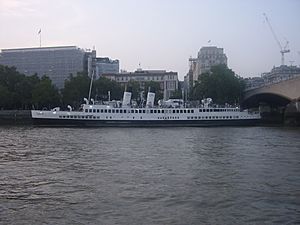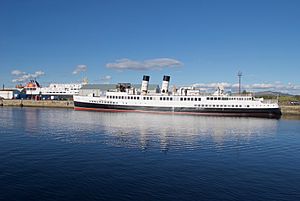TS Queen Mary facts for kids
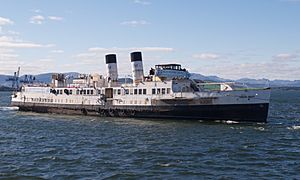
TS Queen Mary arriving back at the Firth of Clyde on 15 May 2016.
|
|
Quick facts for kids History |
|
|---|---|
| Name |
|
| Owner |
|
| Operator | (owners) |
| Port of registry | Glasgow, |
| Builder | William Denny and Brothers, Dumbarton |
| Yard number | 1262 |
| Launched | 30 March 1933 |
| Out of service | 1978 |
| Identification |
|
| Status | Museum ship |
| General characteristics | |
| Tonnage |
|
| Length | 252 ft 6 in (76.96 m) |
| Beam | 35 ft 1 in (10.69 m) |
| Draught | 10 ft 1 in (3.07 m) |
| Installed power | 3,500 ihp (2,600 kW) |
| Propulsion | 3 Parson Steam Turbines |
| Speed | 21 kn (39 km/h) |
The TS Queen Mary is a famous Clyde steamer, a type of ship that sailed on the River Clyde in Scotland. She was built in 1933 at the William Denny shipyard in Dumbarton. This ship is now being brought back to life as a museum ship in Glasgow.
Contents
Building the Queen Mary
The TS Queen Mary was built to carry many passengers. She was 252 feet long and weighed 871 gross registered tons (GRT). This measurement tells us how much space is inside the ship.
She was powered by three special steam turbine engines. These engines helped her reach a top speed of about 19.7 knots (36.5 km/h) during her tests. The ship was designed to carry over 2,000 passengers, making her one of the biggest steamships on the River Clyde.
Early Years and Name Change
The Queen Mary began her service on May 20, 1933. She was based at Bridge Wharf in Glasgow. Every week, she carried around 13,000 passengers on trips to places like the Arran coast and the Kyles of Bute.
In 1935, something interesting happened. Another big shipping company, Cunard Line, was building a huge new ship. They wanted to name their new ship Queen Mary after Queen Mary. So, they asked the owners of the Clyde steamer to change her name.
The owners agreed, and the ship was renamed TS Queen Mary II. In return, Cunard Line gave them a portrait of Queen Mary to display on the ship.
New Owners and Wartime Service
In 1936, the entire fleet of ships, including TS Queen Mary II, became part of the London, Midland and Scottish Railway Company.
During World War II, the ship helped out by delivering mail and carrying passengers to the Scottish Islands. This was an important job during the war.
After the war, the ship was updated and painted in new colours. She went back to her usual passenger trips. In 1948, the railways were taken over by the government. This meant the ship became part of the Caledonian Steam Packet Company.
Modern Updates
Between 1956 and 1957, the ship got a big upgrade. Her engines were changed from burning coal to using oil. This made her more modern and efficient. To do this, her two old boilers were replaced with one new one.
She also got a new, single, modern-looking funnel instead of her original two. A new mainmast was added too, to meet new rules for ship lighting. After these changes, the ship's weight increased to 1014 GRT.
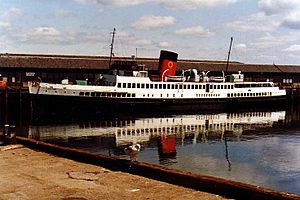
In the 1960s, fewer people were taking passenger trips on the Firth of Clyde. But TS Queen Mary II kept going. She was updated for special cruises from Gourock to places like Inveraray and Campbeltown. Regular trips from Glasgow stopped in 1969.
To keep sailing from Bridge Wharf, her masts were shortened. This was so she could fit under the new Kingston Bridge. However, Bridge Wharf closed before the bridge even opened.
Becoming Caledonian MacBrayne
The Caledonian Steam Packet Company slowly joined with another ferry company called David MacBrayne. In 1973, they became one big company called Caledonian MacBrayne.
In 1976, the ship got her original name back. After the famous ocean liner RMS Queen Mary was removed from the shipping register, the Clyde steamer was officially renamed TS Queen Mary again.
Even though she was popular for special trips, the ship was over 40 years old. She needed a lot of work to keep sailing. So, the decision was made to stop her service. On September 27, 1977, TS Queen Mary made her last public trip. After that, she was stored in Greenock.
Life After Service
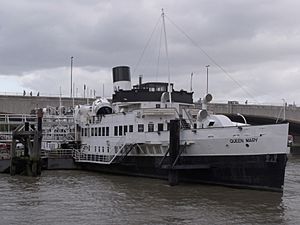
In 1978, the Queen Mary was sold to Glasgow District Council. They wanted to turn her into a museum. But they couldn't find enough money for the project. So, they sold her to a company called Euroyachts in 1980.
In 1981, she was sold again to Tesright Limited. This company moved the ship to London. She was towed there by a tugboat and arrived four days later.
In 1987, Queen Mary was sold to Bass PLC. They spent a lot of money, about £2.5 million, to fix her up. She was then docked at Victoria Embankment in London. She had two bars and two rooms for events. The top deck was an open-air area with another bar.
In 2009, TS Queen Mary was towed to Tilbury. The plan was for her to go to La Rochelle in France. A person named Samuel Boudon bought her. He wanted to turn her into a floating restaurant and fitness centre. But by 2011, this plan didn't work out. She stayed in Tilbury Docks, and her future was uncertain.
A New Hope for the Queen Mary
In 2011, TS Queen Mary was put up for auction and sold to Ranjan Chowdhury. He hoped to bring the ship back to how she looked in the 1930s. In 2012, a group called Friends of the TS Queen Mary was started. Their main goal was to bring the ship back to Glasgow permanently.
In 2015, the ship faced problems. She was stopped from leaving Tilbury because she wasn't safe enough to sail. Later that year, she was held by the Port of Tilbury Limited because the owner hadn't paid her docking fees. It looked like she might be scrapped.
But then, the Port of Tilbury decided to auction the ship. The Friends of TS Queen Mary group, with help from Jim McColl, made a successful bid. They bought the ship in October 2015.
Coming Home to Scotland
In December 2015, a campaign started to raise money for important repairs. Famous actor Robbie Coltrane helped lead the campaign. Many people donated money, and by March 2016, they had raised all £120,000 needed. The repairs began in April 2016.
After being checked by the Maritime and Coastguard Agency, TS Queen Mary was allowed to be towed. On May 15, 2016, she finally arrived back on the Clyde! She stayed in James Watt Dock for the summer.
On September 1, 2016, after raising another £350,000, TS Queen Mary was towed into Garvel Drydock for more renovation work. On October 1, 2016, she returned to James Watt Dock. Then, on November 9, 2016, she was towed to Glasgow. This was her first visit to the city since 1977!
She is now docked at the entrance of Princes' Dock, near the Glasgow Science Centre. Here, she is undergoing a big renovation. The plan is to turn her into a permanent heritage site and an education centre for everyone to enjoy.


